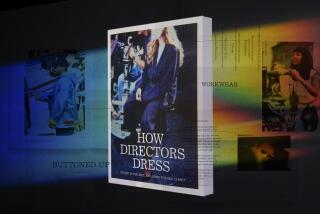Fashion’s allure wore off for him
- Share via
WASHINGTON — For the third time since its namesake retired in 1999, the venerable American fashion house of Bill Blass doesn’t have a lead designer. Its most recent creative director, Michael Vollbracht, had a moment of Paddy Chayefsky clarity and resigned late last week.
Vollbracht had been in Los Angeles to attend a dinner with designer James Galanos -- a man admired for his talent, envied for his ability to work outside the Seventh Avenue system and remembered for dressing former first lady Nancy Reagan. He and Galanos talked about how the fashion industry has evolved into a business focused more on accessories and perceptions of glamour than on clothes. They lamented how it devalues designers who want to dress women -- not girls -- in frocks that make them feel pretty rather than cool or edgy or subversive.
In Vollbracht’s view, fashion ignores older women. It has been hijacked by omnipotent stylists who have a say in celebrity wardrobes, fashion shoots and even runway shows.
“The stylist has more power than I do,” he says. At Bill Blass, “we’re sending thousands of dollars in FedExes to Halle Berry and Catherine Zeta-Jones,” only to have the clothes go unworn. “We’re all sending this [stuff] out there. That’s the thing I didn’t understand, the power of the stylist.” Everyone in the industry is obsessed with celebrities, he says, and every brand is desperate to create a hot new handbag that can feed the bottom line for a year or two.
And then there’s the media talk about the politics of fashion and the meaning of fashion. That’s a distraction, a tangent. All women want “is something they can wear and look pretty and look young,” Vollbracht says.
After his conversation with Galanos, Vollbracht, who regularly traveled the country for trunk shows and was never one to bite his tongue, got on a plane to San Francisco and thought: “I’ve got to do something else.”
So he quit.
“I blame the industry. I don’t blame Bill Blass.... Everyone at Blass has been very nice,” says Vollbracht, 59. “I didn’t know the rules. You’ve got to be with the right stylist, the right models, the right mafia -- when all it just comes down to is ... clothes.”
He has no plans to work in the fashion industry again. Ever.
Vollbracht arrived at Bill Blass in 2003, after Lars Nilsson, who had been lead designer since 2001, was fired. Nilsson had succeeded Steven Slowik, who’d lasted only about one year before he was fired. (Blass died in 2002.)
Vollbracht was an old friend of Blass’ and came out of retirement to take the job. After about 10 years of fizzy success under his own label from the late ‘70s through the ‘80s, he’d closed his business, moved to Florida and focused on illustration.
Vollbracht believed the classic Blass sensibility -- menswear-based tailoring mixed with sassy Scotch-and-soda femininity -- was still relevant and only needed tweaking. He was happy to keep a low profile, content to bolster the Blass name instead of his own. He wanted to woo young customers, but he made it clear that he was not planning to desert the older ones.
Vollbracht emphasized that philosophy in his first collection, for spring 2004. He showed it on veteran models -- women in their 40s and older. It was a fine opening gambit. Over four years, he dressed women as diverse as singer Janet Jackson and First Lady Laura Bush, who wore one of his red skirt suits to the Heart Truth fashion show in February. Actress Angelina Jolie wore his red jersey dress on the cover of the January issue of Vogue.
But Vollbracht’s runway collections often lacked sex appeal. The clothes could be matronly. It became clear Vollbracht had a mature, reserved sensibility that was not in sync with an industry that held up the disheveled, kewpie-doll Olsen twins as tastemakers. “I had someone come up to me and say, ‘You do such beautiful clothes.’ Another woman patted my hand and said, ‘Don’t take that as a compliment.’ ”
Before coming to Blass, Vollbracht had been away from the fashion industry for 15 years. A lot had changed and little of it, Vollbracht says, for the good. He left the first time before the rise of the size 0 model, before the use of teen idols as trendsetters for luxury goods, before fashion became a segment on “Access Hollywood,” before InStyle magazine existed.
During his tenure at Bill Blass, he says, “I had women who loved these clothes.” But that was not enough. Vollbracht may have been the wrong designer for Bill Blass, but in many ways, he is right about the industry.






